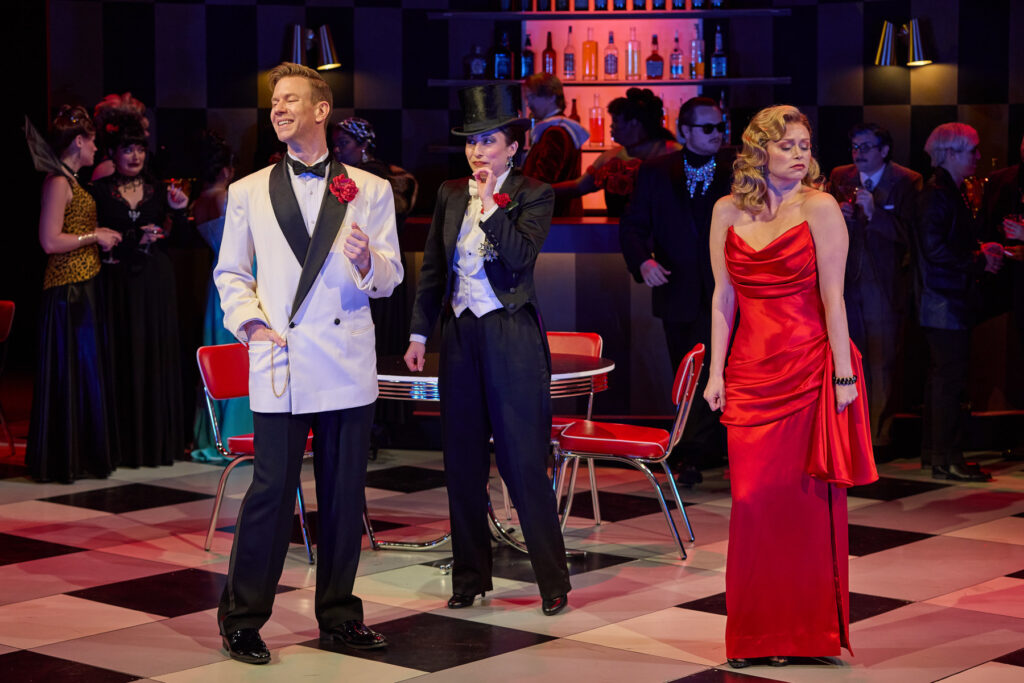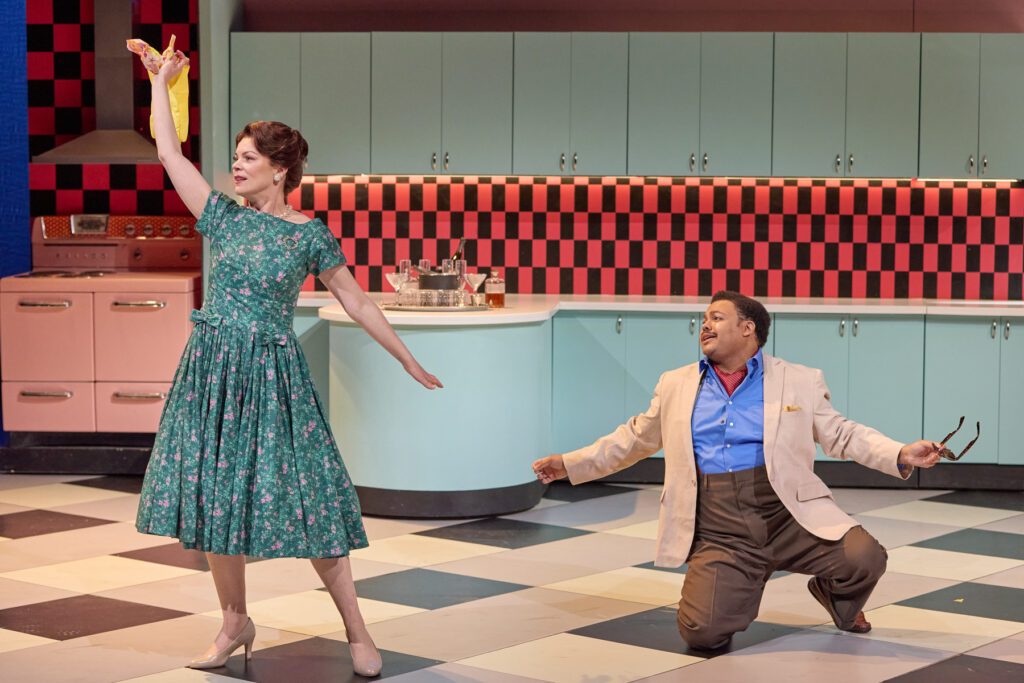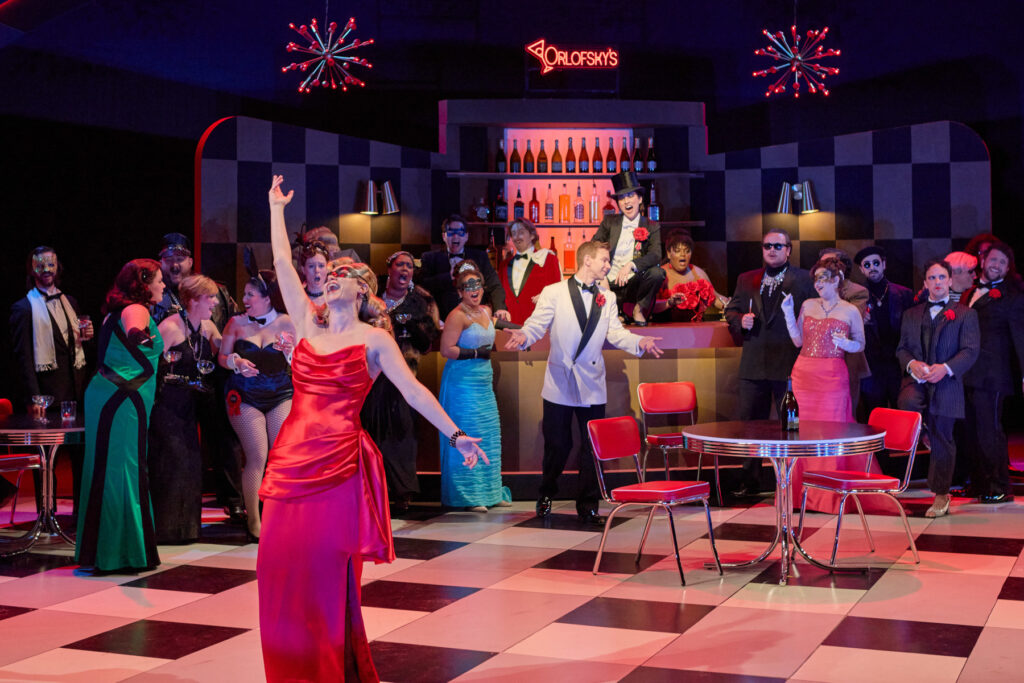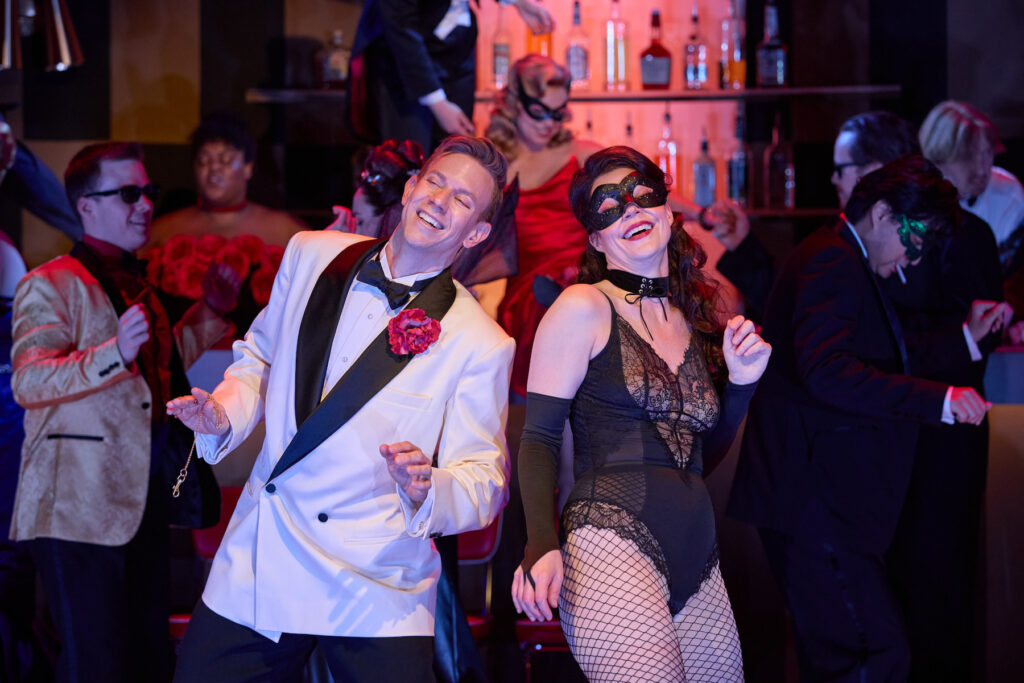Unrelenting, raucous animation was the salient characteristic that pervaded Opera Theatre of Saint Louis’ lively version of that evergreen favorite, Die Fledermaus (The Bat), and the capacity audience roared in approval.
Prima la musica: It is unlikely you could find a better sung Fledermaus anywhere in the country, nay, on the planet. First among equals, Edward Nelson as Eisenstein deployed his sonorous baritone with stylish aplomb, his forceful, well-pointed tone ringing out in the house with ping and poise. Sara Gartland was a perfect match as Rosalinda, her creamy, secure soprano evenly produced in all registers, and her well-schooled technique capable of encompassing the full range of colors and tessitura that this demanding role requires. Moreover, the “Eisenstein’s” rarely look quite this stylish, since this couple is uncommonly svelte, good-looking, and possessed of commanding star presence.

Baritone Jonathan McCullough proved a potent nemesis as Dr. Falke, with fluid, stentorian vocalizing that often shook the rafters with appealing bombastic bluster. It should be noted that Mr. McCullough also offered admirably warm and mellifluous singing when called for as in leading off the great Act II paean to brotherhood. Deanna Breiwick was a treasurable Adele, petite of figure, but with a full-bodied lyric soprano at her command that could lilt and coo one minute, but sass and hurl a punch the next.
Robert Mellon was another commanding baritone as an imperious toned Frank, characterized by testosterone-infused color and impeccable musicality. As Alfred, Joshu Blue sported an assured, gleaming tenor, that not only encompassed the role’s requirements, but also injected an infectious playfulness into his suave music-making.

Kelsey Lauritano proved a winning “they/them” presence as Orlofsky, her plummy mezzo and jaded colorings a perfect match for the cynical Prince. As Dr. Blind, Gregory V. Sliskovich was a lovable Putz with a meaty tenor and a delectable penchant for panicked patter. Rounding out the soloists, Sophia Baete was a lively Sally, deploying her luscious mezz-soprano to make every one of her brief moments count.
Andrew Whitfield’s full throated chorus of Gerdine Young Artists was schooled to perfection, and in the pit, George Manahan elicited an idiomatic and elegant reading from members of the Saint Louis Symphony. Maestro Manahan was in awesome command of his assembled forces and partnered effortlessly with the calculated madness on stage. To this listener, had I closed my eyes, the music for Die Fledermaus cries out: Vienna. Make that: VIENNA!

However, director Shawna Lucey and her “Team Fledermaus” have set it in 1959 New York, a goof that involves a Barbie dream kitchen in the suburbs (think pink appliances), a visit to the Playboy Club (named Orlofsky’s), and a final act in a police station on the wrong side of town. It all begins in the subway, where Eisenstein and Falke are returning home in a drunken swagger, from a Halloween party dressed as Green Lantern and Batman respectively (get it, “Bat” man?). Falke passes out and embarrasses himself in front of the morning commuters. And so we see the set-up for Falke’s revenge that is only traditionally described in the plot.
The thing is, this all happens during the world famous overture, which becomes, in effect, Metro Muzak. Happily, that is the last time the music gets eclipsed by the Konzept. The presentational style is immediately established as a bit manic, over the top, and. . . fourth wall? What fourth wall? The stilted dialogue declamation seemed pitched in volume to a third balcony, when there was really only one. But I have to concede, the jokes all landed solidly.

Director Lucey used the stage extremely well, devised enough inventive stage business for three normal farces, and exuded an absolutely committed vision from first to last. If it sometimes seemed to me like Ms. Lucey threw the Strüdel at the wall to see what would stick, the audience ate it up with a healthy portion of Schlag. Seán Curran contributed the effective movement that engages the entire cast in flowing stage pictures.
Ruth and Thomas Martin’s venerable English translation provided the high toned sophistication that was a perfect partner to Strauss’s musical invention, and stood in some contrast to the souped up antics of the sometimes crass dialogue. The leading roles are certainly to be admired for totally immersing themselves in almost non-stop hijinks and robust physicality. Ms. Gartland’s Hungarian princess was the Gabor star turn it must be even as she strips to her scanties; and when Mr. Nelson combined hip swiveling footwork with fey mannerisms, he was as goofily endearing as, and a visual ringer for, Sean Hayes on Will and Grace.
In the dual roles of the bartender and the jailer Frosch, Oscar Olivo was, well. . .let’s just say he may not make it into Who’s Who, but he is a shoo in for What Was That? His energy could power the city of Saint Louis, and the spastic gyrations and rapid verbal non sequiturs in his jailhouse rant prompted an outburst of applause, perhaps as much for his inspired lunacy, as for his finally having stopped talking!
The colorful, eye-catching scenery (that proved highly suitable for chewing) was designed by Robert Innes Hopkins, who also delighted with his wide array of period-inspired costumes. Bringing Falke back in Act Three in his Batman costume was an inspired touch, and the entire look of the show and its three major sets was clever and appealing. This is also owing in no small part to Eric Southern’s evocative lighting design, that not only conveyed the times of day, but also the moods of the moment. The contrast of shadows and reds in Act II was notably fine. The spot-on wigs and make-up by Krystal Balleza and Will Vicari completed the productions meticulous look.
If this jubilant, unabashed, re-imagined production was not your Grossmutter’s Die Fledermaus, the standing, cheering crowd at opera’s end was elated to have experienced an evening of unfettered joyfulness.
James Sohre
Die Fledermaus
Music by Johann Strauss II
Libretto by Carl Haffner and Richard Genée,
After Henri Meilhac and Ludovic Halévy’s Le revéillon
Alfred: Joshua Blue; Adele: Deanna Breiwick; Rosalinde: Sara Gartland; Gabriel von Eisenstein: Edward Nelson; Dr. Blind: Gregory V. Sliskovich; Dr. Falke: Jonathan McCullough; Frank: Robert Mellon; Sally: Sophia Baete; Prince Orlofsky: Kelsey Lauritano; Ivan/Frosch: Oscar Olivo; Conductor: George Manahan; Stage Director: Shawna Lucey; Set and Costume Designer: Robert Innes Hopkins; Lighting Designer: Eric Southern; Wig and Make-up Designers: Krystal Balleza, Will Vicari; Choreographer: Seán Curran; Chorus Master: Andrew Whitfield
Top image: (L to R) Johnathan McCullough as Dr. Falke, Sara Gartland as Rosalinde, and Edward Nelson as Eisenstein
All photos © Eric Woolsey